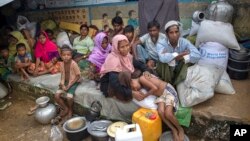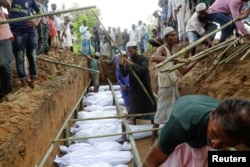Fleeing violence at home, Kamal Hossain left Myanmar’s northern Rakhine State two months ago. But he didn’t arrive in Bangladesh until this week.
The journey to the border involved a trek and then a wait as boatmen charged too much money.
“So we swam across the river,” he said.
More than two months after the Rohingya crisis started, following insurgent attacks on security posts and a military crackdown, members of the stateless Muslim minority are still arriving in Bangladesh.
The United Nations has called the campaign ethnic cleansing. Myanmar's government has rejected the term, even as more than two-thirds of the one million or so Rohingya with homes in Rakhine have now left.
A crackdown on ferries slowed some of the arrivals in October, which is why some – like Hossain – swam across the Naf River separating the two countries using jerrycans as buoys.
Jakaria Alfaz, a Bangladeshi journalist based in Cox’s Bazar, said he recorded at least 19 Rohingya youths crossing that way.
“They swim across in a small group with their plastic jerrycans (fuel containers). They told me that they have been starving for many days and could hardly find any shops to buy available food,” he said. “Once they reached [Bangladesh], the border guards took them into custody and sent them to government-designated camps.”
The number of people seeking haven in Bangladesh since the violence erupted on August 25 is now more than 600,000. Myanmar’s government has created a resettlement and repatriation program, but it is still new and untested.
Reasons for fleeing
Meanwhile, life in Rakhine State is anything but back to normal. The reasons for the continued outflow are varied, but stem from lack of transportation, hunger and the threat of violence.
Vivian Tan, a spokesperson for the UN refugee agency, was in southern Bangladesh this month and spoke to some of the new arrivals. She said in an email that most of them were from Buthidaung Township in northern Rakhine.
“A few say their homes were razed in late August but they stayed in relatives' villages before finally deciding to leave now,” she said. “Many others report that they received daily warnings to leave or be killed, and finally fled when their homes or neighbors' homes were razed.”
“In short, on the refugees' reasons for fleeing, I would say that it remains a combination of direct violence, fear of impending violence, and deprivations like food shortages,” she added.
Northern Rakhine has been largely closed off to journalists and aid workers since the fighting began, so independently verifying the accounts of those arriving in Bangladesh has been close to impossible.
State media reported on Sunday that the government had started to harvest abandoned fields.
More than half of the 28,000 hectares in Maungdaw Township “saw no signs of being harvested by owners,” theGlobal New Light of Myanmar reported.
Last week, the World Food Program said the government had allowed it to resume aid, but it has not started yet.
“WFP has been given the green light to resume food assistance operations in the northern part of Rakhine State and is currently coordinating with the Government to work out the details,” Silke Buhr, WFP spokesperson, said in an emailed statement on Monday.
Bangladesh has attempted to crack down on boatmen ferrying Rohingya across the river, citing extortion and trafficking risks.
Afruzul Haque Tutul, deputy police chief in Cox’s Bazar, said authorities are not allowing boats to operate to and from Myanmar, and that additional police forces have been deployed on the southern tip of Bangladesh.
“As a result of this, many desperate Rohingya now are looking for other options to flee their country and some tried to swim across the Naf River,” he said. “Some 20 Rohingyas have so far crossed the Naf River, but we do not appreciate their life-threatening swimming [attempts].”
Even for boat passengers, however, the waters have proved fatal.
At least 190 people, most of them Rohingya, have been found dead since August 25 while trying to reach Bangladesh through the river or the Bay of Bengal farther south.
Bangladeshi authorities have arrested and convicted up to 469 middlemen who have brought Rohingya refugees over by boat, usually for a cost.








